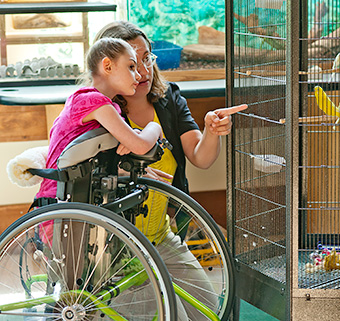
Last week, Rifton offered the first in a series of webinars. Standers: What does the research say? Watch the recording below to learn interesting research findings on tone, ROM, bone mineral density, and hip stability.
Packed into 30 minutes, this webinar includes interesting research findings on muscle tone and range of motion, bone mineral density, and the issue of hip displacement for children with cerebral palsy. In addition, a brief overview of Rifton standers offers information on stander features and tips for positioning children in standing.
Read the transcript of the Webinar here.
During the live stream, we received several questions that we'd like to share the answers to below:
Emily: Can we have a short description of some of the language around types of standers? I've seen reference to dynamic and passive standers - please clarify.
This article differentiates between Rifton's supine, prone, and mobile standers. Put simply, with a passive stander the person’s anatomy is positioned vertically through extrinsic supports, with no active muscle action involved. In a dynamic stander there is weight-shifting, weight-bearing, and a degree of movement at the joints which necessitates intrinsic involvement of the person’s own muscles and joints. The key point is that there are muscle forces present. (In physics, “dynamics” deals with forces and their relation primarily to the motion but sometimes also to the equilibrium of bodies.) Rifton’s mobile stander allows for some dynamic standing. Also check out EasyStand’s Glider and Kaye Products Dynamic Stander. In this presentation (see References PDF for link to the Damcott 2013 study) the researchers created their own moving foot plates which they placed on the commercially-obtained standers used in the study.
Joanne: Can you discuss how you make standing dynamic/active?
Using the Rifton Mobile Stander, the key is the positioning of the seat pad. By lengthening the two lower straps of the seat pad, this will enable more weight bearing through the legs. As the child maneuvers the large wheels and mobilizes throughout their environment, they will naturally perform weight shifting and more dynamic weight bearing. Another concept while stationary is to lower the seat pad and place it at an angle to encourage a slight squat while “seated” on the seat pad, and then the child moves up from this position into a fully standing position against the body support system. This loading/unloading can occur intermittently throughout the standing session.
Andrea : What is your opinion on use of the supine stander on a child diagnosed with osteoporosis and a history of fractures of both femurs with placement of an IM rod in one?
Each child’s case requires the direct ongoing clinical judgment and guidance of a health professional working directly with the child and family. As professionals, while we value the use of standers for multiple reasons, we must remember that use of standers must be integrated into the child’s quality of life experience. The benefit of the Rifton supine stander is that it provides full body support and enables a gradual transition from horizontal to upright such that tolerance for the position can be closely monitored. However, we must recognize that there must be loading through the long bones to improve BMD, as bone remodeling is triggered by the mechanical forces of dynamic loading and muscle strain on bone tissue. This article on Rifton’s website may be helpful: Adaptive Standers and Bone Mineral Density
Jane: Is there anything in the research indicating what the minimum standing angle should be to gain benefit?
In preparing this webinar, I did not find research studies discussing the minimum standing angle. In this presentation (see References PDF for link to the Kecskemethy 2008 study) an interesting research study took a closer look at weight bearing that occurs while in a stander and found that can vary considerably. You may want to check that out. From a clinical judgment standpoint, the more vertical the stander is, the more of this weight bearing may occur, as less of the child’s body weight is supported by the board of the stander. For a prone stander, moving the angle toward the horizontal may result in increased activation of the spinal extensor muscles of the neck and upper back against gravity for postural muscle strengthening.
Back to Top